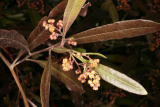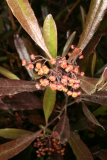Additional notes (click to expand)
Commemorative
This small shrub from New Zealand gets its name from the Flemish physician Rembert Dodoens
(1517–85). He studied geography, medicine and cosmology at Leuven (Louvain), Belgium, graduating in 1538. Dodoens practised initially in Mechelen (Malines) in the province of Antwerp. Later, while working in Basel (1542–6), he prepared the material for his important herbal, the Cruydeboeck (published in 1554). He was still physician in Mechelen in 1558, becoming physician to the Austrian emperor Rudolph II from 1575–8, and thereafter was professor of medicine at Leiden from 1582 until his death. The Cruydeboeck had over 700 woodcuts of plants, mostly copies
of those in Leonhart Fuchs’ herbal, De historia stirpium commentarii insignes (Notable commentaries on the history of plants, the small octavo, 1551 edition, not the large quarto first edition of 1542) and the text follows the same format. Dodoens translated his Cruydeboeck into Latin with the title Stirpium historiae pemptades sex (1583), which was in turn translated into English by Dr Priest of the College of Physicians (later to be known as the Royal College of Physicians), and published by John Gerard as his Herball, or General historie of plantes (1597). Quite why Gerard bothered is obscure as it had already been translated into English and published as A nievve Herball or historie of Plantes (1578) by Henry Lyte. Lyte’s version was translated from
the French translation of the Cruydeboeck, the Histoire des plantes (1588), made by Charles
de L’Escluse (also known as l’Écluse and/or Carolus Clusius), and while it is in the same order as the original it has large sections (eg Equisetum) omitted. Gerard’s version seems more complete, but the order is completely different from Lyte’s. All these books were enormously influential in plant-based medicine by virtue of their extensive illustrations, but their debt to Fuchs is obvious.
Oakeley, Dr. Henry. (2012). Doctors in the Medicinal Garden. Plants named after physicians. Royal College of Physicians.
link
Horticulture
This vigorous, frost-hardy, evergreen shrub, in the family Sapindaceae comes from open woodland on well-drained soils in South Africa, Australia and Mexico. This cultivar has handsome red-purple foliage which, at the back of the border, acts as an attractive backdrop for other plants from the southern hemisphere. Its leaves are protected by a sticky exudate, which helps it to resist drought and pollution from London traffi c. Cutting back into old wood is not advisable, but responds well to light clipping in spring to maintain a balanced shape. All our specimens were killed in the –10°C frosts of 2010–11 and have been replaced (by Clare Beacham).
Oakeley, Dr. Henry. (2012). Doctors in the Medicinal Garden. Plants named after physicians. Royal College of Physicians.
link
Dodonaea viscosa Jacq. 'Purpurea'
Family: SAPINDACEAEGenus: Dodonaea
Species: viscosa Jacq.
Cultivar: 'Purpurea'
Common names: Hopshrub; Florida hopbush; Narrow-leaf hopshrub; Wedge-leaf hopbush
Distribution summary: Africa, Asia, Australasia, Americas
Habit: Shrub
Hardiness: H3 - Half hardy; unheated greenhouse/mild winter
Habitat: Dry, sunny, rocky slopes
Garden status: Currently grown
Garden location: Southern Hemisphere (K), Southern Hemisphere Wolfson bed (N)
Flowering months: June, July, August
Reason for growing: Commemorative, medicinal


.JPG)

.JPG)